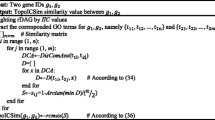Abstract
Biological ontologies are widely used for genome annotation. Identifying correspondences between concepts of two ontologies (mapping) allows the reuse and sharing of annotations. Accordingly, biological ontology mapping has attracted a lot of interest. In this paper, we introduce O’Browser, a semi-automatic method for mapping two functional hierarchies using two sets of carefully annotated proteins. While being based on a classical ontology mapping architecture, O’Browser computes correspondences using a combination of different kinds of matchers. A key feature of O’Browser is that it places the expert at the center of the mapping process at two stages: (i) both to validate the very strong correspondences discovered by the system and to identify functional groups of concepts and (ii) to validate the correspondences given by the combination of results found by the matchers. These matchers have been designed in O’Browser to fit best with functional hierarchy features. For instance, we have introduced a new instance-based matcher which uses homology relationships between proteins. The combination of the different matchers is based on an original notion of adaptive weighting. Here, we show the ability of O’Browser to map concepts of Subtilist to concepts of FunCat, two functional hierarchies. First results appear to be very promising.
Preview
Unable to display preview. Download preview PDF.
Similar content being viewed by others
References
Rison, S., Hodgman, T., Thornton, J.: Comparison of functional annotation schemes for genomes. Functional & Integrative Genomics 1, 56–69 (2000)
Riley, M.: Systems for categorizing functions of gene products. Curr. Opin. Struct. Biol., 388–392 (1998)
Moszer, I., Jones, L., Moreira, S., Fabry, C., Danchin, A.: Subtilist: the reference database for the Bacillus subtilis genome. Nucleic Acids Res. 30, 62–65 (2002)
Ruepp, A., Zollner, A., Maier, D., Albermann, K., Hani, J., Mokrejs, M., Tetko, I., Güldener, U., Mannhaupt, G., Münsterkötter, M., Mewes, H.: The FunCat, a functional annotation scheme for systematic classification of proteins from whole genomes. Nucleic Acids Res. 14(32(18), 5539–5545 (2004)
The Gene Ontology Consortium: Creating the gene ontology resource: design and implementation. Genome Res. 11, 1425–1433 (2001), http://www.geneontology.org
Bodenreider, O., Aubry, M., Burgun, A.: Non-lexical approaches to identifying associative relations in the gene ontology. In: Pacific Symposium on Biocomputing, pp. 104–115 (2005)
Euzenat, J., Shvaiko, P.: Ontology Matching. Springer, Heidelberg (2007)
Kalfoglou, Y., Schorlemmer, M.: Ontology mapping: The state of the art. In: Dagstuhl Seminar on Semantic Interoperability and Integration, vol. 04391 (2005)
Ontology Matching web site, http://www.ontologymatching.org
ISWC 2008 Third International Workshop on Ontology Matching, Karlsruhe, October 26 (2008)
Noy, N.F., Musen, M.A.: Anchor-PROMPT: Using non-local context for semantic matching. In: Proceedings of the workshop on Ontologies and Information Sharing at the International Joint Conference on Artificial Intelligence (IJCAI), pp. 63–70 (2001)
Aumueller, D., Do, H.H., Massmann, S., Rahm, E.: Schema and ontology matchering with COMA++. In: Proceedings of SIGMOD 2005 (2005)
Hu, W., Yuzhong, Q., Gong, C.: Matching large ontologies: A divide-and-conquer approach. Data Knowl. Eng. 67(1), 140–160 (2008)
Ontology Alignment Evaluation Initiative, http://www.oaei.ontologymatching.org
Kirsten, T., Thor, A., Rahm, E.: Instance-based matching of large life science ontologies. In: Cohen-Boulakia, S., Tannen, V. (eds.) DILS 2007. LNCS (LNBI), vol. 4544, pp. 172–187. Springer, Heidelberg (2007)
Altschul, S., Gish, W., Miller, W., Myers, E., Lipman, D.: Basic local alignment search tool. J. Mol. Biol. 215, 403–410 (1990)
Levenshtein, V.I.: Binary codes capable of correcting deletions, insertions, and reversals. Soviet Physics Doklady 10, 707–710 (1965)
O’Browser website, http://www.lri.fr/%7erance/obrowser/
Lemoine, F., Labedan, B., Froidevaux, C.: GenoQuery: a new querying module for functional annotation in a genomic warehouse. Bioinformatics 24, 322–329 (2008)
Noy, N., Musen, M.: PROMPT: Algorithm and tool for automated ontology merging and alignment. In: Proc. of AAAI 2000, pp. 450–455. MIT Press, Cambridge (2000)
Do, H.H., Rahm, E.: COMA - a system for flexible combination of schema matching approaches. In: VLDB, pp. 610–621 (2002)
Azé, J., Gentils, L., Toffano-Nioche, C., Loux, V., Gibrat, J.F., Bessières, P., Rouveirol, C., Poupon, A., Froidevaux, C.: Towards a semi-automatic functional annotation tool based on decision tree techniques. In: BMC Proceedings, International Workshop on Machine Learning in Systems Biology, MLSB 2007, vol. 2(4) (2007)
Author information
Authors and Affiliations
Editor information
Editors and Affiliations
Rights and permissions
Copyright information
© 2009 Springer-Verlag Berlin Heidelberg
About this paper
Cite this paper
Rance, B., Gibrat, JF., Froidevaux, C. (2009). An Adaptive Combination of Matchers: Application to the Mapping of Biological Ontologies for Genome Annotation. In: Paton, N.W., Missier, P., Hedeler, C. (eds) Data Integration in the Life Sciences. DILS 2009. Lecture Notes in Computer Science(), vol 5647. Springer, Berlin, Heidelberg. https://doi.org/10.1007/978-3-642-02879-3_10
Download citation
DOI: https://doi.org/10.1007/978-3-642-02879-3_10
Publisher Name: Springer, Berlin, Heidelberg
Print ISBN: 978-3-642-02878-6
Online ISBN: 978-3-642-02879-3
eBook Packages: Computer ScienceComputer Science (R0)




